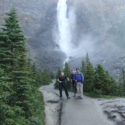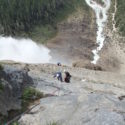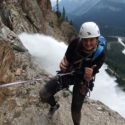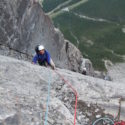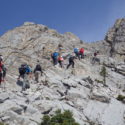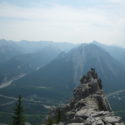Why should cadets have all the fun? There have been a number of international trips for cadets in recent years but this was the first overseas trip designed specifically to allow Cadet Force Adult Volunteers (CFAVs) the opportunity to broaden their mountaineering and climbing experience. Officer Commanding Cadet Centre for Adventurous Training (CCAT), Major Kev Edwards, who came up with the idea, did all the hard work of planning and fund raising to make the expedition happen. He roped in his usual suspects of alpine instructors and little persuasion was needed to encourage a bunch of Army Cadet Force and Combined Cadet Force adults to head out to Canada to experience the best of the Rockies. Based at a hostel on the banks of the Bow River in Banff, the group spent three superb weeks exploring a small portion of the climbing on offer in the Bow valley, the Yoho National Park and the Kananaskis valley.
The first day was spent settling in, victualing and familiarisation. On long trips, this is time well spent for the smooth running of the remainder of the expedition, but is often overlooked by people with limited experience of long, overseas trips. Establishing a solid base and setting ground rules is all important. Adventurous Training is about more than the hard skills of climbing technicalities; it is funded because of the opportunities it offers for service personnel to stretch themselves physically and mentally, take responsibility for their actions, exercise teamwork, make dynamic risk assessments and demonstrate leadership.
Good weather windows on arrival, with some variable weather forecast thereafter, led to the decision to go high early and get a mountain day under the belt. The day on Mt Lorette (2467m) gave an early indication of the climbing conditions in the area and the inaccuracies in the guidebooks! Lorette was described as a good introductory peak, 6-8 hours in duration with an easy descent down a scree gully. Fifteen hours later a somewhat shattered bunch had completed their first peak. The exposed pitches and knife-edge ridge traverse were truly exhilarating but the slog up to the ridge and the scree gully and bleached rock river bed descent that had, in part, been washed out by the 2013 floods, made for a challenging first day.
After that first mass ascent, the group split into three teams, choosing different areas in which to work. Over the 3 weeks, Kevin/Cath’s team managed 1675m of pitched climbing on multi pitch routes, over a vertical mile of climbing. If you consider each climb necessitated at least 3 hours of walk in and walk out, you get some idea of the nature of the undertaking.
Notable ascents by various groups included:
North East Ridge of Ha Ling Peak, Canmore. Formerly known as Chinaman’s Peak, this mountain can be summited by a tourist track, but the more adventurous 12 pitch climb with sections of 5.6, was of epic proportions. With the usual hazards of stone-fall, route finding and lack of protection, there was the additional entertainment of being lapped by Argentinian and Canadian parties! Technical traverses and a bold 90m corner/slab section led eventually to a top out amongst brazen chipmunks trying to steal sandwiches. The one great relief was the descent, an easy, if long, switch back route following the afore mentioned tourist track.
Takakkaw Falls in Yoho National Park was for many the highlight of the expedition. The 350m waterfall presents an imposing sight at the entrance to Waterfall valley. “Nine pitches of sheer awesomeness” and a 75m tunnel crawl through pica droppings made for an exhilarating climb to the lip of the falls. Whilst shielded from the falls for much of the climb, stepping out next to the thunderous rooster-tail on pitch 6 was an awesome experience. The crux section went at 5.7 but most, other than a rather awful 5.2 pitch through a shale band, was a combination of enjoyable 5.5 – 5.6 pitches and exposed traverses. If nothing else, we provided a spectacular sight for the hundreds of tourists who stood at the base of the falls looking on in amazement and photographing the hardy souls above.
Mt Rundle dominates the eastern side of Banff and the Rundle Horn is a classic guide route on the arête. Five delightful pitches of slab climbing provided first sport leads for a number of group members and a lesson in accurate foot placement for all. On the arête itself, the climbing became more mixed and the rock less solid but the views evermore spectacular over the Banff Springs Hotel and the Bow Valley.
Cascade Mountain looms over Banff to the north and Cascade Falls is the first sight that many people see as they turn off the TransCanada Highway at Banff. A little to the right of the falls lies Mother’s Day Buttress, an exposed and exciting route that consists of 8 pitches of good climbing in the 5.5 – 5.6 grade range. On a sunny day the rock is warm to the touch and views outstanding at every stage. Not all the groups were so fortunate with the weather however, climbing in mist and rain for the majority of the route.
Yamanuska is one of the earliest areas climbed in the Rockies, with the first routes put up by British climbers. The route chosen was Easy Street, so called as one of the easier routes on the crag, a 6 pitch route going at 5.6. No surprise then, that 3 of the 4 parties on the entire crag, a huge escarpment rising up to 18 pitch routes, were closing in on the same route! Fortunately for us, the party ahead backed off and the party that followed us seemed to experience some difficulties on the first pitch and never caught us up, despite the fact that we had two teams on the same route. As we bush bashed our way off (yes, another guide book inadequacy!), we could still hear the cries of the only other group further along the crag. One hates to think what time they got off.
Nanny Goat Crag, sitting alongside the famous Yamanuska area, is a popular multi-pitch destination with a shorter walk in. Keelhaul Wall provided an enjoyable 5 pitch outing going at 5.6 but with a couple of moves that really concentrated the mind. The final pitch was a text book example of smear climbing on slab limestone (with obligatory long run outs!), its very roughness indicating how little travelled these big routes, although close to civilisation, are.
Pinnacle Mountain (3047m) lies near Lake Louise. According to the guidebook and despite its height, it is a seldom visited mountain but has a fabled visitors’ book located somewhere near the summit. The ascent from the car park followed a steep but well defined track that was littered with bear warnings and an insistence on group travel only. After a few kilometres an amphitheatre of three major peaks loomed, with Pinnacle at the centre. After an arduous 2 hour scramble up a scree slope the technical ascent began. Two climbing teams assaulted separate gullies. Each gully had a dark and eerie atmosphere made worse by the amount of loose rock and shale. For one group, the first pitch was about 40m of grade 5.5 and although the climbing was not challenging, progress was hampered by desperately poor rock and the danger of rock fall. The second phase of the climb was a steep scramble up the remainder of the gulley. Here the rock fall was incessant and made the climb arduous, taking a further two hours to gain 100 metres of ascent. On reaching the first ridge, a traverse was made under a ledge into a smaller side gulley of about 30 metres to climb up to the second and final pitch. Each climber made their way to the short gulley one at a time whilst the remaining climbers took cover under the ledge and was subjected to a rock fall bombardment that lasted for over an hour and a half until the final climber had moved through. At the base of the second pitch, 70 metres short of the summit, and with time and conditions against them, the decision was made to retreat back down the mountain. The other party had taken this decision after only 3 pitches of difficult route finding on poor rock, avoiding verglas and rock fall. Descending, their misfortune was to be caught in the horrendous rock fall caused by the first group who had continued on. Never was there a better illustration of the importance of making the right call at the right time. The move back down to the car park took a further four hours. Overall, Pinnacle proved to be a challenging mountain that was a much of a test of good decision making as it was of skill, teamwork and nerve.
Mountain weather can never be relied on and during the three week expedition we had our fair share of glorious sunshine, torrential thunder showers and celtic clag. Spells of good weather were used to the full but poor weather did curtail activities on several occasions, reducing us to the indoor climbing wall in Banff and single-pitch cragging on several occasions. It did also give opportunities for well-deserved rest days; 12 pitch multi pitch climbs preceded by 2 hours of ascent and followed by 2 hours of walk off take a toll both physically and mentally. It had always been the intention to climb some big, alpine peaks, but the changeable weather earlier on precluded this. The long-range forecast indicated that weather windows of sufficient length were limited but the hope was to finish the trip on a high, summiting Mt Athabasca (3487m) during a favourable window in the final week, at the first opportunity. The group headed north on the Ice fields Parkway, a stunning highway showcasing the most spectacular mountain panoramas. Our objective was the Athabasca Glacier. An afternoon was spent perfecting the skills required for efficient glacier travel, dodging the tourist snow-coaches (yes, they really do drive across the glacier itself!) and marvelling at the beautifully sculptured ice forms and glacial-fluvial features. Unfortunately, late in the afternoon the storm clouds grew and the weather became evermore threatening. During the night, a spectacular thunderstorm raged loudly and very brightly through the valley and as we woke at 4am it became apparent that the weather was not stable enough to attempt an ascent on Athabasca. This was a disappointing outcome but a decision that no one questioned in the less then favourable conditions.
It is fair to say that every member of the group has thoroughly enjoyed the Canadian expedition and has had the opportunity to develop their climbing technique, confidence and resilience. Alpine climbing, whether it is on mountain ridges, big face climbs or snow peaks, is a fickle beast that requires sound judgment and a healthy respect for the scale of the undertaking. The CFAVs are very grateful to the CCAT instructors who led their teams so expertly during the expedition and imparted their collective years of experience and we are all grateful to the funding bodies who made the expedition possible, including the Ulysses Trust, BIBMTF, the AMA and ACFA/CCFA. Most of all we are grateful to Kev Edwards for having the inspiration to make the project happen through his dedication and hard work. The CFAVs return home inspired to continue their climbing progression and further promote adventurous training within the Cadet organisation, which is what it is all about.

